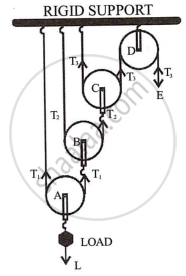Advertisements
Advertisements
प्रश्न
Draw a diagram of a combination of three movable pulleys and one fixed pulley to lift up a load. In the diagram, show the directions of load, effort and tension in each strand. Find:
- mechanical advantage,
- Velocity ratio and
- efficiency of the combination in ideal situation.
उत्तर

A, B, and C are a movable pulley and D is a fixed pulley.
- M.A.
In equilibrium, Effort E = T3 ...(i)
Since the two string segments that cross pulley A support the load L, tension T1 in this string is 2T1 = L.
or T1 = `L/2` ...(ii)
Similar to how the two sections of string that cross pulley B support tension T1, tension T2 in this string is
`2T_2 = T_1 or T_2 = T_1/2 = L/2^2` ...(iii)Likewise, the string tension T3 that crosses the pulley C is
`2T_3 = T_2 or T_3 = T_2/2 = L/2^3` ...(iv)
from (iv)
Load L = `2^3 xx T_3` ...(v)
E = `L/2^3` ...(vi)
Hence, mechanical advantage
M.A = `"Load L"/ "effort E"`
= `(2^2 xx T_3)/T_3 = 2^3` ...(vii)
Generally speaking, if there are n movable pulleys and 1 fixed pulley.
M.A = 2n here n = 3
∴M.A. = 23 ...(i) -
Velocity Ratio: When a string crosses a movable pulley, its other end travels up twice as far as the pulley's axle moves. This is because one end of the string is stationary. If the load L attached to the pulley A moves up by distance X i.e. dL = X, the string connected to the axle of pulley B moves up by a distance 2 × x = 2x, the string connected to the axle of pulley c moves up by a distance 2 × 2x = 22 x and the end of the string moving over the fixed pulley D moves up by a distance 2 × 22 x = 23 x, i.e. the effort E moves by a distance 23x or dE = 23 x
∴ Velocity Ratio V.R. = `("distance moved by effort" d_E)/("distance moved by load" d_L)`
= `(2^3x)/(x) = 2^3` ...(ii) - Efficiency = `("M.A.")/("V.R.")` ...from (i) and (ii)
η = `2^3/2^3 = 1 or 100%`
APPEARS IN
संबंधित प्रश्न
Is the above pulley system an ideal machine or not?
What is a pulley?
Differentiate between a single fixed pulley and a single movable pulley.
Name a machine to change the direction of force ?
Explain the working of a gear system.
Give a reason for the following:
In a single fixed pulley, the velocity ratio is always more than the mechanical advantage.
Write two uses of pulleys. Is pulley a force multiplier?
In the case of a block and tackle arrangement, the mechanical advantage increases with the number of pulleys. Explain.
Draw a diagram showing a block and tackle system of 4 pulleys.

(i) State, how many strands of tackle support the load?
(ii) Draw arrows to represent tension in each strand.
(iii) Find the mechanical advantage of the system, stating the assumptions made.
(iv) If the load is pulled up by a distance 1m, how much does the effort end move?
Name the type of single pulley that has an ideal mechanical advantage equal to 2. Draw a labelled diagram of the pulley mentioned by you.
